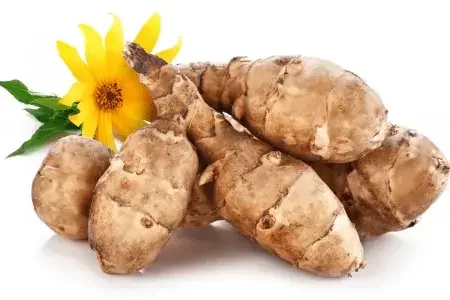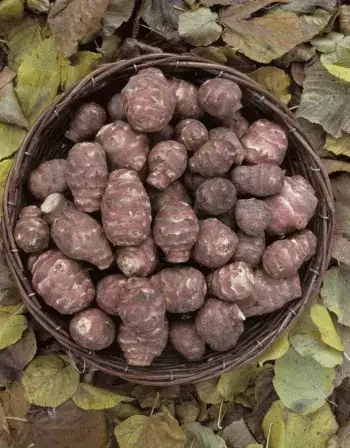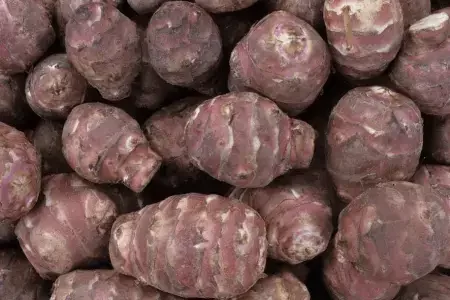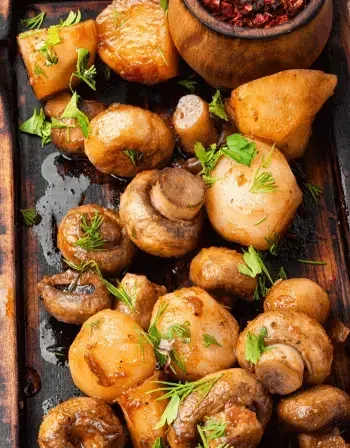Jerusalem Artichoke (Sunchoke), Helianthus tuberosus
The Jerusalem Artichoke is a species of sunflower native to North America. It grows native in almost all US States and Canadian Provinces. The Globe Artichoke, Cynara cardunculus is not related to the Jerusalem Artichoke, Helianthus tuberosus. This is care-free plant that anyone can grow.
Jerusalem Artichoke is grown for food & flowers! Fifteen (15) Native American tribes used it for food! Harvest and eat the roots (tubers) just like a potato! Jerusalem Artichoke recipes are below. Or, grow Jerusalem Artichoke flowers! This plant produces a LOT of large yellow flowers. Pollinators love the flowers.
Tubers have excellent nutritional and medicinal qualities. One cup provides a lot of iron and potassium. It’s also a good source of copper, magnesium and phosphorus. However, studies below show its best qualities. It’s potent in fighting against type 2 diabetes! I provide the studies below!
Sunroot, Sunchoke or Wild Sunflower are other common names. It’s disease and pest free and very drought tolerant. We water them only once or twice per year! Grow Jerusalem Artichokes in containers or in the ground! We grow the variety called, Red Rover. For us, Red Rover flowers better than Brown-eyed Susan, and grows more vigorously than other Jerusalem Artichokes we’ve planted.
________________________________________
see our list of 400 edible plants
YouTube channel (please subscribe)

Jerusalem Artichoke in garden design, permaculture, and organic gardening


Jerusalem Artichoke, Helianthus tuberosus
common names: Earth Apple, Sunroot, Sunchoke, Topinambur, and Wild Sunflower.
Fact Sheet
Zone: 3 to 9
Height: 6 – 10 feet
Native: North America
Bloom Time: August – September
Bloom Color: yellow and many flowers!
Fruit Maturity: after first-frost (to harvest roots)
Self-fertile: yes
Sun: full sun
Water: low
Soil: forgiving (wide range)
Maintenance: little
Growth Rate: fast
Deciduous or evergreen: perennial (growth above-ground dies-off; roots send-up new growth in Spring)
Edible¹: yes (discussed below)
Medicinal²: possibility (discussed below)
Commercial viability: good (discussed below)
Family / Genus: Asteraceae / Helianthus
Remarks: fresh Jerusalem Artichoke flowers attract insect pollinators; spent flower seeds attract finches; excellent drought tolerance; excellent flowering plant with edible roots!
As an Amazon Associate, HEPPY earns from qualifying purchases (paid link).
Here’s a list of all the products we truly use and trust.
Jerusalem Artichoke in landscaping and garden ideas
Native to North America, it grows wild in virtually all US States and Canadian Provinces.
Landscape Architecture
Jerusalem Artichoke is an excellent plant to grow along a fence or treeline. A fence, treeline or wall will protect it’s tall stalks from wind. Also, there MAY be a tendency for the roots to spread and the plant may self-seed. Consequently, a colony of it will develop. Be mindful of location and the variety you select.
The plant will grow across North America. It makes an ideal plant to add color and size. Jerusalem Artichoke flowers provide food for pollinators. Also, birds will enjoy the seeds after the flowers die.
Give it full sun and, little or no water is needed.
Garden Ideas
Full sun, no water and tall stalks with large yellow flowers! Jerusalem Artichoke flowers are amazing. Also, harvest roots to make dishes just as you would with potatoes! Jerusalem Artichoke recipes are below!
Be mindful of claims that it self-seeds and spreads by rhizomes to form colonies. The variety we grow does not spread or, is spreading very little. In fact, I will be spreading the roots to other locations! HOWEVER, we grow only the Jerusalem Artichoke, Red Rover variety.
Growing Jerusalem Artichokes in pots
Growing Jerusalem Artichokes in containers is easy. This is a undemanding plant. I recommend using loose soil to allow its tuberous roots to expand. Full sun is needed to get the most flowers (at least 6 hours) . However, potted plants in full sun have a tendency dry. You will loose some of the plant’s inherent drought tolerance. Overall, very little watering is needed.

As an Amazon Associate, HEPPY earns from qualifying purchases (paid link).
How to Grow and Harvest Jerusalem Artichoke
Helianthus tuberosus is disease and pest free at HEPPY™. This colorful flowering plant. Grow it for cut flowers, for pollinators and birds, or for food!
Sun & Soil
Full sun assure that YOU see the most Jerusalem Artichoke flowers. Loose, organic-rich soil will give the roots (tubers) room to expand! However, it grows native in almost all US States and Canadian Provinces. That tells me that she’s VERY adaptive to sun and soil. Optimal conditions — full sun and rich soil — will provide the biggest ‘bang’ out of this girl!
Harvest Jerusalem Artichoke
Harvest begins after the stalks turn brown. Start harvesting by cutting-away the brown stalks.
Many credible sources recommend harvesting after the first frost. However, they can be harvested at anytime during the winter!
Maryland Farm and Harvest, Episode 907 (19:26) shows how easy it is to harvest. Use a tool such as pitchfork to loosen the soil. Then, harvest Jerusalem Artichoke roots!
Storing Jerusalem Artichoke roots
Cold storage is ideal. Store Jerusalem Artichoke roots as you would carrots, potato and other root vegetables. In cold climates, store in a root cellar, garage or other cold location. However, roots can also be stored in a refrigerator, especially in warmer climates.
Green Light Plants provided additional tips. “Like beans, sunchokes … can be very gassy. One tip we’ve learned to offset the gas … is to wait until the first frost of the season to harvest them or flash freeze them once they’re out of the ground. The freezing changes the chemistry of the tuber to a more easily digestible root vegetable.”

Jerusalem Artichoke Recipes
Jerusalem Artichoke roots have a nutty, earthy flavor. You can roast, bake, mash, sautée, grill, or eat it raw. Slice and dice the root or, use a grater or food processor. Add grated roots to almost ANY dish! Also, you can eat it with the skin! Just rinse off the dirt!
Sunchoke Latkes (Potato Pancakes, Potato Fritters)
Latkes
– 1½ Lbs. Jerusalem artichokes (sunchokes), peeled and shredded
– 1 Lbs. baking potatoes, peeled and shredded
– 1 large carrot, peeled and shredded
– 1/3 cup all-purpose four
– 1 tsp. salt- ¼ tsp. black pepper
– 1 large egg, lightly beaten
– 1 large egg white, lightly beaten
– 1/3 cup olive oil, divided
Aji Verde Sauce
– 1 medium Jalapeno, stem, seeds, and ribs removed
– 1 medium shallot
– 1 clove garlic
– 2 Tbs. lemon juice
– 2 Tbs. orange juice
– 1 tsp. salt
– 1 cup chopped cilantro
– 1 cup mayonnaise
– Peel, then shred artichokes, potatoes, and carrot on a large box grater or in a food processor with a grating disk. Place shredded vegetables in a large bowl and toss to combine. Add flour, salt, and pepper to vegetables and gently mix. Add egg and egg white; stir until just combined.
– Heat half of oil in a large nonstick skilled over medium high heat. To see if oil is hot enough, test a small spoonful of latke batter. If it sizzles immediately, oil is hot; if it reacts slowly, carefully continue heating oil.
– Using a ¼ measuring cup, add latke batter to hot oil. Do not crowd pan. Cook latkes three minutes on each side, or until crispy and browned. Remove from pan and place on a wire rack over a rimmed baking sheet, so that oil can drip away. (To keep warm while cooking others, place baking sheet in an oven at 200 degrees.) Repeat until all latkes are fried, making about 10 total. Serve immediately with applesauce, sour cream, or Aji Verde Sauce.
Aji Verde Sauce: Combine all ingredients in blender and puree. Serve immediately with hot latkes.
Jerusalem Artichoke Soup
Cook tubers as you would cook potatos!
Or, use this tasty looking recipe from FineDiningLovers.com:
- Heat butter and olive oil, then add onion, garlic, celery, salt, thyme, marjoram, and the Jerusalem artichoke. Once the vegetables have been cooked through, add the chicken stock and simmer for 35-40 minutes.
- Puree the soup in a blender, return it to medium-low heat, and incorporate the cream. Keep warm until ready to serve.
- Thinly slice the Jerusalem artichokes, rinse several times, and dry well. Make sure there is no water remaining on them or else it will cause the frying oil to combust.
- Deep-fry the artichoke chips in frying oil at 180°C | 355F for 3-4 minutes or until golden. Drain oil from the chips on kitchen paper.
- Serve the soup with the chips and thyme resting on top.
Roasted or Baked Jerusalem Artichoke
Halve the tubers lengthways. Cover in vegetable or olive oil. Season to taste. Season with salt and pepper, and maybe paprika or garlic powder!
Add sprigs of thyme, marjoram, rosemary, garlic chives, or whole garlic.
Bake them in the oven at 350 degrees for about 45 minutes. Bake until tender and golden.
Eat raw Jerusalem Artichoke
Grate or chop tubers onto salads, or as a topping on soups!
Please subscribe to our YouTube channel.
Or, support us by making any purchase on any item on Amazon after clicking here.

As an Amazon Associate, HEPPY earns from qualifying purchases (paid link).
Native American tribes ate Jerusalem Artichoke
Fifteen American Native tribes ate Jerusalem Artichoke roots. The 15 documented tribes are the Cherokee, Cheyenne, Chippewa, Dakota, Hopi, Huron, Iroquois, Lakota, Malecite, Micmac, Omaha, Pawnee, Ponca, Potawatomi, and Winnebago.
Roots were eaten raw like a radish (Chippewa). Roots were boiled and sometimes fried after boiling (Dakota). It was a food source in Spring (Hopi). It was also dried and eaten during famines (Lakota). Eaten “raw, boiled or roasted” is often cited. Helianthus tuberosus is a well-established, North America wild food source.
Nutritional and Medicinal qualities of Jerusalem Artichoke
Nutritional qualities
One cup of Jerusalem Artichoke root provides iron (28%) and potassium (18% of daily need). Also, it’s a good source of copper, magnesium and phosphorus. No grams of fat and only 110 calories.
Medicinal qualities
Helianthus tuberosus has medicinal qualities. It’s best qualities is fighting against type 2 diabetes. It looks like modern medical studies have supported this folk remedy.
Jerusalem artichoke in folk remedy
Often cited is “Jerusalem artichoke is a folk remedy for diabetes and rheumatism.” The quote is from Dr. James A. Duke’s book, Handbook of Energy Crop. Dr. Duke was an American botanist and worked for the US Dept. of Agriculture. He was a prolific author who wrote books on medicinal plant information. Therefore, you can trust that Jerusalem Artichoke truly was used as a folk remedy for diabetes.
Jerusalem artichoke in modern studies
Beneficial effects in the prevention of the onset of type 2 diabetes
This study explored the molecular mechanisms that underlie the beneficial effects of Jerusalem Artichoke in the prevention of type 2 diabetes. It is a complicated study. However, they conclude that 10% Jerusalem Artichoke supplementation may be used as a potential therapeutic approach for preventing the onset of type 2 diabetes. Unfortunately, there’s always the word, “potential.” Government agencies should be funding what the scientific community is not completing. What are the undeniable facts!
Jerusalem artichoke as a medicinal plant
This study searched other studies to evaluate if Helianthus tuberosus is a medicinal plant, and what natural products can me made of it (emphasis added)!
Jerusalem artichoke (JA) has multiple applications thanks to its rich chemical composition…It can be used in medicine and the pharmaceutical industry, because it contains anti-fungistatic, anti-carcinogenic and antioxidant components, and the production of the raw material is easy and inexpensive. It also lowers high cholesterol, triglycerides and high glucose levels; facilitates weight loss; detoxes the organism (e.g. alcohol, heavy metals, radionuclides); lowers uric acid levels; has immunostimulating properties; protects the gastric mucosa, prevents constipation; prevents acne; improves metabolism in lipid disorders; reduces body mass; has cytotoxic properties in breast cancer. It also helps in cardiovascular diseases, chronic infectious diseases; chronic fatigue syndrome; gut flora disorders; immune system disorders.”
Suppress Glucose Levels: Eat Sunchoke / Jerusalem Artichoke at Breakfast Rather Than at Dinner
This study found that eating Sunchoke for breakfast is more effective at suppressing the after dinner or lunch spike in glucose.
“our study demonstrated that the intake of Helianthus tuberosus [eat Sunchoke] in the morning … is a more effective way to suppress postprandial [the period after dinner or lunch] and 24 h glucose levels and improve the intestinal environment.”


As an Amazon Associate, HEPPY earns from qualifying purchases (paid link).
Jerusalem Artichoke growing at HEPPY™
What didn’t grow (for us)
In 2017 I purchased the native variety of Helianthus tuberosus. I just started gardening and also, had poor deer protection. The plants died. The deer had their fill and the plants never re-emerged the following spring. Also, it could have been my bad luck.
Jerusalem Artichoke ‘Red Rover’
I was in New York state to buy the Franklinia Tea Tree, Franklinia alatamaha. I saw this “strange” variety of Helianthus tuberosus called, ‘Red Rover.’ One gallon plant for $10.00 — I bought it! (Catskill Native Nursery, 2022.)
WOW! What a terrific plant! We watered once/twice all year in 2023 — the week we got to 95+ degrees for days!
Red Rover variety developed rich foliage, and so many flowers. Tall and sturdy. The roots will not be eaten this winter. Instead, I look forward to planting the Jerusalem Artichoke ‘Red Rover’ in two of three other locations!





